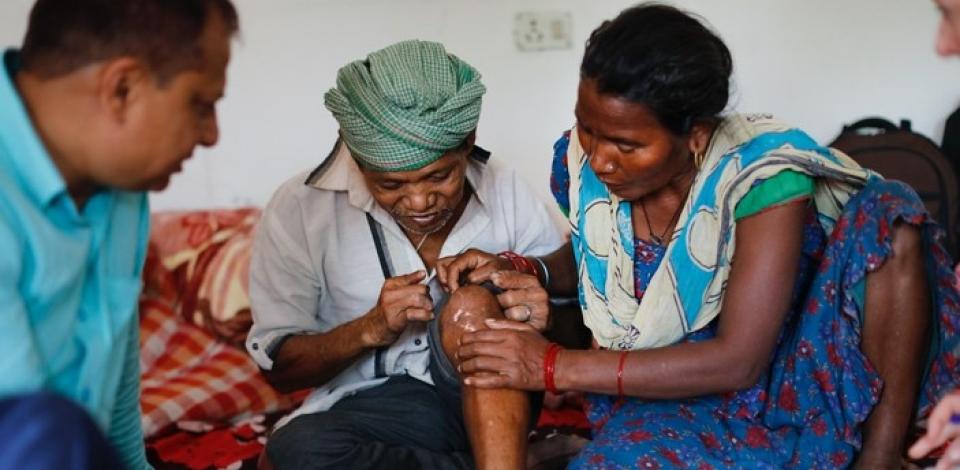Time zero
Before the moment – ‘time zero’ – when a person is diagnosed with a neglected tropical disease (NTD), the person and their family may not feel they are ‘affected’ by the NTD. They may have noticed changes to their bodies, may experience pain and may have started to worry about what might be affecting them.

The golden hour
The ‘golden hour’ is the moment when the person affected receives the diagnosis. The person may or may not be in the company of family members, and may or may not suspect the diagnosis, but is certainly anxious to get a treatment for the condition and be cured right away. However, in the case of diseases associated with stigma and discrimination, the diagnosis may be perceived as bad news, not only because the treatment may be long, but also because the person may need to disclose the diagnosis to family members and contacts to get them examined for the same disease. Many people may be ashamed of being affected by such a condition, which may lead them to conceal it. Others may simply reject or deny the diagnosis, especially if they have been to other doctors who have made a different diagnosis. Others may fall into a state of despair, running away, isolating themselves from everyone, or even considering suicide.
The golden hour is extremely important because it is through the medical diagnosis that the person and the family may feel like they lose their social status in the community and in the world. Actual loss of status may or may not occur, but the potential, anticipated loss enters the person’s life. The degree of perceived loss depends on several factors, including the way the person is addressed during this ‘golden hour’.
Whilst the moment of first diagnosis is very important, some conditions only become stigmatising when secondary effects such as physical impairments are apparent. This can happen many months or even years after diagnosis, but can have many of the same effects: shame, concealment, isolation and despair.
Exercise 1
In this exercise you are invited to ‘step into someone else’s shoes’. How does it feel to be stigmatised, to be excluded? Gain an in-depth understanding in this exercise. See Guide 2 Annex 1: Training exercises and tips for further details.
Case study from a psychologist working with leprosy patients in India
A woman came to the hospital along with her neighbour. They were both invited into the doctor’s room, the doctor assuming the neighbour was a family member. He broke the news that the woman had leprosy and gave instructions about the treatment. The neighbour heard it all. A few days later, the patient came back to the hospital very upset, saying that her employer had fired her. Later she came again, this time having attempted suicide. She had been preparing for her daughter’s marriage, but this had been cancelled by the in-laws once they heard that the mother of the bride had leprosy. The neighbour who had accompanied her to the hospital had told the whole village about her health condition.
If you are the health care provider, you should anticipate and be prepared to handle overwhelming emotional reactions from the person affected and/or family members. In managing and helping the person with their emotional reactions, it is important that you:
- Acknowledge and accept the reactions of the person, however strong they may be. For example, you might reply, ‘I can see that you are upset’.
- Encourage expression of feelings. If people are crying or are angry, convey to them that they can feel free to express themselves and that they have reasons to feel the way they feel. Assure them of your understanding presence.
- After they settle down, help explore the reasons for their feelings, for example by asking questions such as ‘What makes you feel this way?’ and ‘What is upsetting you?’
- Encourage the person to discuss the situation in detail.
- Help the person to explore options to manage the situation.
The golden hour is crucial in the course of the treatment as a key moment to promote adherence to treatment, promote contact examination and prevent mental health problems. Three points need to be considered during the ‘golden hour’:
- Communicating information sensitively and clearly about the diagnosis, treatment and progress of the condition.
- Voluntary disclosure of the condition to others.
- Communication with household members – what to tell family members and how to encourage them to help affected persons cope.
Guide 2 Annex 2: Crucial points to consider during the ‘golden hour’ provides a detailed description of the points that need to be considered during the ‘golden hour’. The Annex includes more information about important topics to consider and address, useful questions to ask and more general information about sensitive and clear communication.

Identify support needed
After the golden hour, the normal schedule of regular health care appointments begins. During these appointments, health workers need to be attentive to possible comorbid events, including distress in the family, loss of job or source of income, and isolation, in addition to physical evolution and adaptation to the medication, prevention of disabilities etc. Persons affected by NTDs may go through the treatment smoothly, or they may go through a path of challenges that should be tackled as they are identified. In this Guide, we identify several levels in which people can face challenges: individual, group and family. Guide 2 Annex 3: Flowchart, from ‘time zero’ to intervention provides a visual overview of the different levels identified in this Guide.
